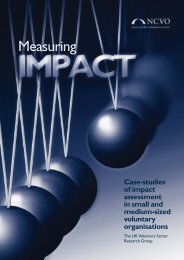A guide to third sector trading - WCVA
A guide to third sector trading - WCVA
A guide to third sector trading - WCVA
You also want an ePaper? Increase the reach of your titles
YUMPU automatically turns print PDFs into web optimized ePapers that Google loves.
It’s an idea, but is it business? A <strong>guide</strong> <strong>to</strong> <strong>third</strong> sec<strong>to</strong>r <strong>trading</strong><br />
1: Getting<br />
started<br />
2: First steps 3: Business<br />
planning<br />
4: Legal and<br />
governance<br />
5: Funding<br />
and<br />
resourcing<br />
6: Financial<br />
controls<br />
7: Managing<br />
growth<br />
8: Management<br />
and<br />
governance<br />
9: Social<br />
enterprise<br />
10: Sources<br />
of support<br />
− As long as that payment is made <strong>to</strong> the parent charity within<br />
nine months of the end of a particular accounting period, the<br />
company can treat the donation as paid in that accounting<br />
period (rather than the current year).<br />
− This gives a charity-owned company time <strong>to</strong> calculate its<br />
profits precisely, so that it can donate its entire profit, and<br />
reduce its corporation tax liability <strong>to</strong> nil.<br />
− If a charity-owned company makes Gift Aid donations of less<br />
than the full amount of the corporation tax profit within ninemonths<br />
of the end of an accounting period, it cannot claim<br />
further tax relief on any remaining profit which it donates<br />
later.<br />
• This nine-month ‘carry-back’ facility applies only <strong>to</strong> companies<br />
which are wholly owned by one or more charities. This covers:<br />
− subsidiary companies limited by shares where all the ordinary<br />
share capital is owned by charities (or by a company owned<br />
by a charity)<br />
− companies limited by guarantee owned by charities – ie<br />
where their memorandum and articles make it clear that their<br />
beneficiaries are charities or subsidiaries of charities.<br />
• Estimated donations: There is a risk of tax complications if<br />
estimated profits are donated <strong>to</strong> a charity and they turn out<br />
later <strong>to</strong> exceed the actual profit. The original donation must be<br />
properly recorded by both the company and the charity. Check<br />
the implications with HMRC guidance or your accountant.<br />
Private sec<strong>to</strong>r partnerships: Companies which are owned<br />
jointly by a charity and a separate private company are subject<br />
<strong>to</strong> different rules. Joint ventures are complicated arrangements<br />
where mistakes in taxation planning could be costly and even<br />
divisive. It is assumed that <strong>trading</strong> ventures of this complexity will<br />
be subject <strong>to</strong> professional guidance on taxation arrangements<br />
even before they are set up. But you should be aware that:<br />
• In practice a donation <strong>to</strong> the charity which is proportionate <strong>to</strong><br />
the charity’s shareholding will be treated as profit distribution<br />
and not eligible for tax relief under Gift Aid.<br />
• Such companies are still able <strong>to</strong> make Gift Aid donations<br />
provided they are not linked <strong>to</strong> shareholding.<br />
Further information:<br />
For further information and guidance on how <strong>to</strong> deal with<br />
more complex issues check the HM Revenue and Cus<strong>to</strong>ms web<br />
site www.hmrc.gov.uk/charities.<br />
201












